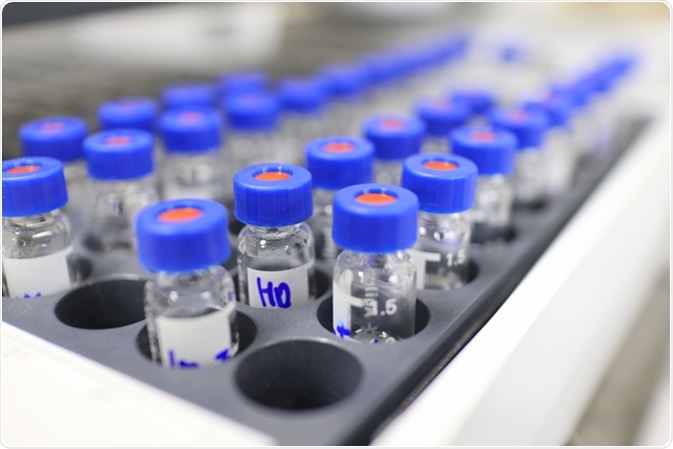High performance liquid chromatography, more commonly known by the acronym HPLC, is a method used to identify substances in a mixture.
There are several types of HPLC, such as reversed-phase, denaturing, and immobilized enzyme reactor (IMER) HPLC.
The types of HPLC can vary broadly, both in what they achieve and in how they are carried out. This fundamentally affects how and when HPLC methods are applied, but all in all, HPLC has proven to be useful in diagnostic purposes and in the pharmaceutical industry.

Image Credit: Hotsum / Shutterstock
Clinical Diagnosis
Catecholamines such as epinephrine and dopamine are highly important for many biological functions. Analyzing their precursors and metabolites can provide diagnosis of diseases such as Parkinson’s disease, heart disease, and muscular dystrophy.
However, given how physiologically widespread these molecules are, their analysis and subsequent conclusions about patient health must be done carefully. HPLC has the ability to separate and compare molecules to a higher magnitude than other techniques, making it a great candidate for such diagnostic purposes.
Reversed-phase HPLC (RP-HPLC) is one of the more popular methods due to its speed, column stability, and capacity to separate a wide range of compounds.
Identification of molecules in HPLC is done by measuring retention time. Retention time is the time it takes a molecule to pass through a column lined with adsorbents which interact differently with different molecules. This is done under varying conditions. In 1976, the potential use for RP-HPLC in diagnostic settings was shown.
Researchers exploited hydrophobic properties to separate catecholamine metabolites and amines in the same run, thereby speeding up the process. This is partly due to an interaction with pH, as acidic catecholamine metabolites are retained for longer at low pH values, but vice versa for amines.
Several conditions and settings can be modified in HPLC protocols. HPLC can then be used not only to detect diseases as mentioned, but also to monitor the progression of diseases.
Pheochromocytoma is a potentially fatal tumor of the sympathetic nervous system. It is derived from tissue in the neural crest, which implies that it secretes catecholamines. It can cause hypertension, which can complicate diagnosis, because it may only differ from hypertension in the format of its metabolites.
This makes HPLC ideal for diagnosis, however, the origin of the sample to be analyzed can affect the results. Urinary samples will reflect metabolites from both the central nervous system and the periphery.
Using cerebrospinal fluid offers results more localized to the central nervous system, and is therefore preferred.
Pharmaceutical Industry
With the widespread production of pharmaceuticals, came the legislation to ensure proper production and purity of drugs distributed. HPLC is among the most commonly used methods to verify drug purity globally.
Its use in assessing drugs on an industrial scale started in the 1980s, though its use in some countries is prevalent but still less widespread.
This can potentially be due to cost. HPLC is capable of providing sufficient precision for the industry standard, but only when it is preceded by calibration tests. This can increase the costs, but this sacrifice leads to high accuracy and specificity.
This means HPLC can be more beneficial to ensure purity than other methods. Multiple crystallization method was previously used, but had the drawback of potentially wasting expensive drugs. HPLC is much more efficient, and it minimizes losses to pharmaceutical manufactures.
Even at the start of HPLC usage in pharmaceutical industry, the method showed its usefulness. HPLC was used in the analysis of alkaloids, antibiotics, and steroids.
Steroids, in particular, were previously somewhat difficult to analyze owing to low dosages in medicines, and the impractical forms they often came in (creams and ointments).
Early discussion focused on the detector used, a debate which still continues and evolves, but given the multitude of methods currently available, the debate is much more complex than it once was, and can vary depending on the type of HPLC being considered.
HPLC is not only used for analysis of the finished drug products. Since HPLC can separate compounds, it is also applied during manufacture.
Through this separation, HPLC can provide critical starting products for the manufacture of new drugs, or characterization of molecules with the potential to be manufactured into drugs.
These lead compounds can be derived from plants, animals, or fungi. HPLC can be used to separate enantiomers, the molecules which are mirror images of each other, using chiral stationary phases (CSPs).
The ability to prove purity of enantiomeric molecules is a standard in pharmaceutical assays, for which HPLC is suitable.
The most popularly used CSPs in pharmaceutical chemistry are polysaccharide benzoate and phenylcarbamate derivatives.
Further Reading